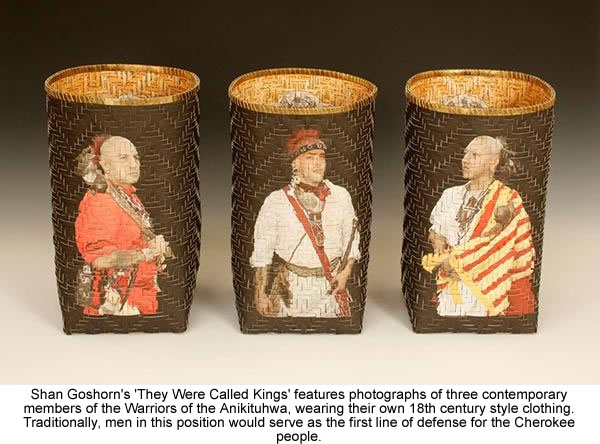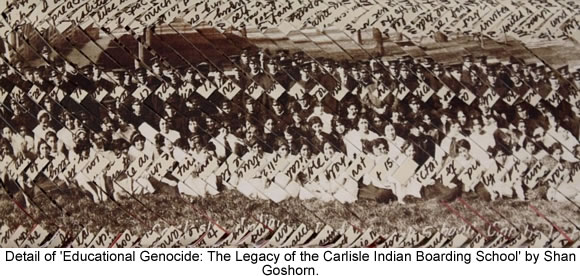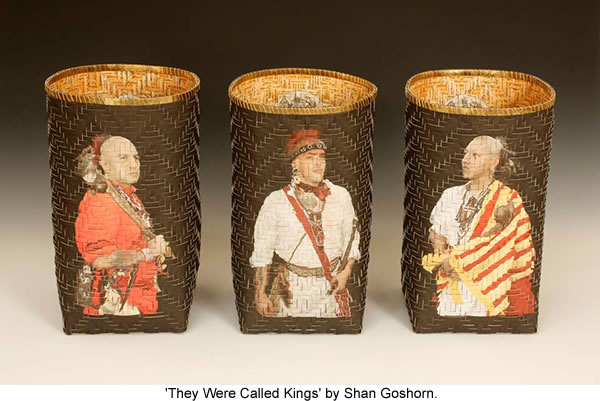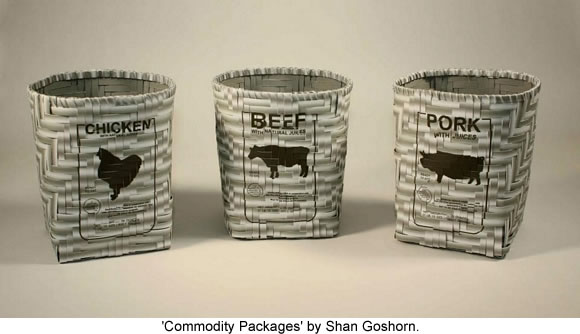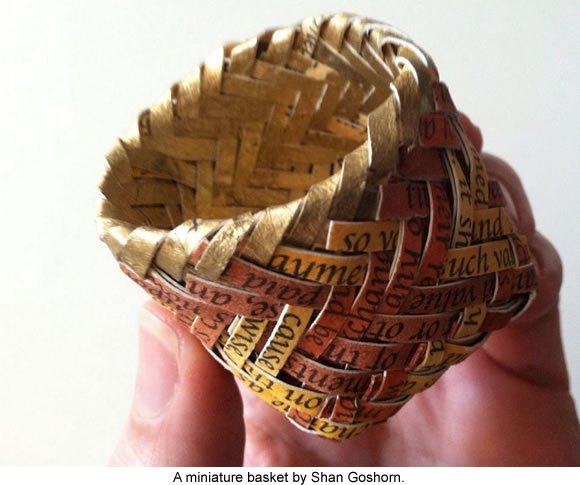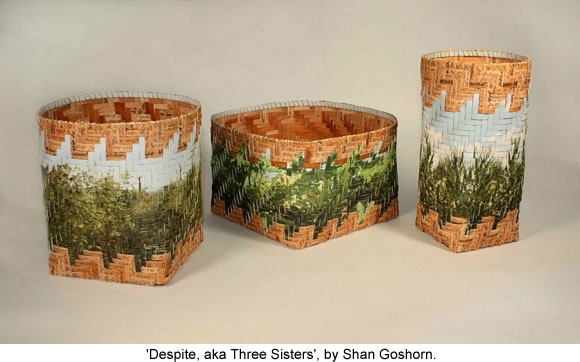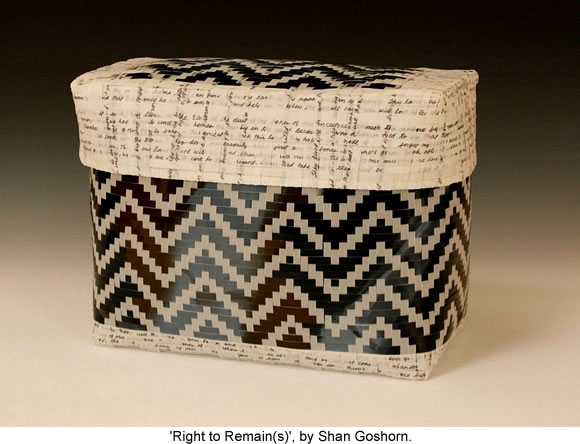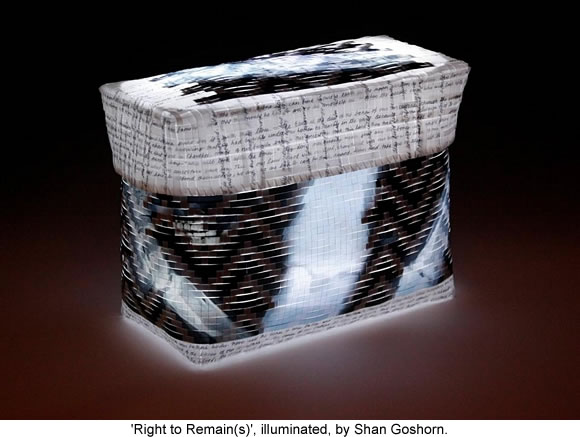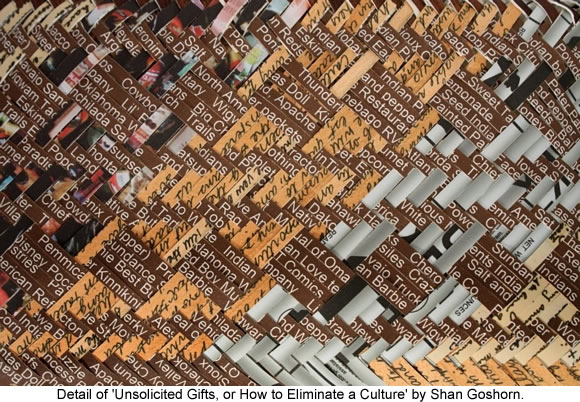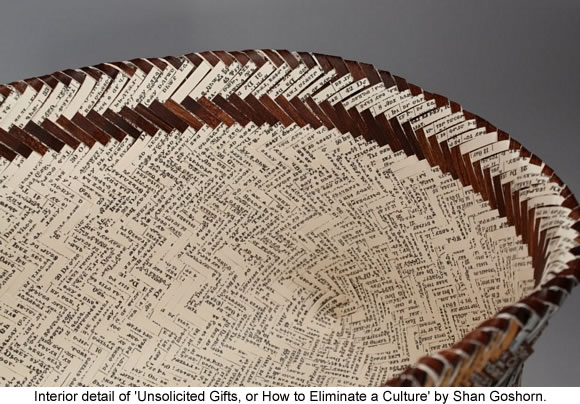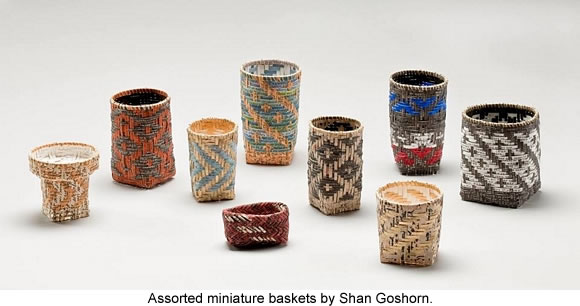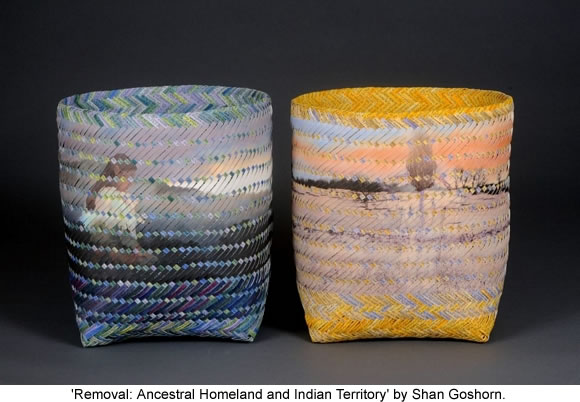 |
Canku Ota
|
 |
|
(Many Paths)
|
||
|
An Online Newsletter
Celebrating Native America
|
||
|
January 2014 - Volume
12 Number 1
|
||
|
|
||
|
An Activist's Baskets:
The Unique Art of Shan Goshorn
|
||
|
By Lee Allen - Indian
Country Today Media Network
|
||
|
credits: photos courtesy
of Shan Goshorn
|
|
"While I may be relatively new to the art of basket making itself, I've always been a human rights activist," says Eastern Band of Cherokee artist Shan Goshorn, who thinks the two concepts go well together. And judging from the reception her artistic statements are getting, she's right. Goshorn is one of 16 artists tapped for a 2014 fellowship by the Native Arts and Cultures Foundation. The honor comes with a $20,000 grant.
"My work over the last 25 years has always addressed human rights issues, mostly those that affect Indian peoples today, but it wasn't until 2008 that I made my first basket and 2011 until I got the hang of it and it really took off."
When she was in her early 20s, Goshorn was commissioned by the Indian Arts and Crafts Board to illustrate about 20 pen and ink drawings of Cherokee basket designs. "By the time I got to number 16, I thought -- you know what, I can do this and I can combine the process with issues of sovereignty. "The first piece I did illustrated a tobacco compact between the Cherokee Nation and the State of Oklahoma over the problem of taxation of smoke shops on tribal lands. I took the piece and wove a traditional pattern called a spider's web to show how tangled the agreement was. I left it deliberately unfinished because I wanted to show how the negotiations appeared. And it was a statement that worked as this one ended up in the National Museum of the American Indian."
Her work has been displayed in many prestigious collections --- the Smithsonian Institution, the Institute of American Indian Arts, the Museum of the Cherokee Indian, and the Department of the Interior. She has also won numerous awards from major competitions like the Grand Prize at Red Earth Indian Art Festival. "While my work may invite controversy, my intent is to invite dialogue as a result of that controversy. The reason this works is that people are intrigued by the traditional shapes, colors, and patterns and become interested in learning more about what the basket has to say."
And her baskets all contain a message, from that of Indian removal through the Trail of Tears to contemporary domestic violence -- "Everything from concepts of Christianity to the use of our names and stereotypical images in commercials to a burden basket that includes the burdens Indian people have carried for decades." Goshorn calls her work "traditional contemporary" for a reason. "There's an old saying that civilization is judged by the art it leaves behind. These paper baskets will last up to 200 years under the right conditions, but they're not about longevity, they're about creating dialogue now, engaging the viewer to lean in, see the piece, and understand some of the issues continuing to affect us today. Some people say, ‘get over it, that was 200 years ago,' but these issues are still relevant in today's society."
Believing that "baskets are perfect vehicles for political statements" and fearless in her convictions, Goshorn creates her double-woven art by utilizing materials like reproductions of the Indian Removal Act of 1830; historical maps showing the downsizing of Cherokee lands, and student rosters from what she calls "educational genocide" that went on at Carlisle Boarding School. One creation, titled Sealed Fate, is made of splints cut from paper printed with historical treaty documents aimed at removing Cherokee people from their homeland. The basket interior is woven from 95 pages -- 14,000 signatures of tribal members -- who disputed the legality of that document.
Attesting to her prowess as weaver of baskets, Goshorn says she is one of only a handful of Southeastern tribal artists who have mastered the double-weave or double-wall technique in which each basket is formed by an interior and exterior wall seamlessly woven together. Instead of the traditional split river cane used to make baskets, she uses a wood pulp paper infused with commercial dyes, a process called giclee where images are generated from high resolution digital scans and printed with archival quality inks. She says that process has revolutionized her abilities. "Field gathering natural materials takes up a huge portion of time for traditional basketmakers, while my time is spent gathering historical research for my work which I hope will re-weave Indian history ."
Shan
Goshorn Studio |
|
|
||
|
|
||
| Canku Ota is a free Newsletter celebrating Native America, its traditions and accomplishments . We do not provide subscriber or visitor names to anyone. Some articles presented in Canku Ota may contain copyright material. We have received appropriate permissions for republishing any articles. Material appearing here is distributed without profit or monetary gain to those who have expressed an interest. This is in accordance with Title 17 U.S.C. Section 107. | ||
|
Canku Ota is a copyright ©
2000 - 2013 of Vicki Williams Barry and Paul Barry.
|
||
 |
 |
|
|
The "Canku
Ota - A Newsletter Celebrating Native America" web site and
its design is the
|
||
|
Copyright ©
1999 - 2013 of Paul C. Barry.
|
||
|
All Rights Reserved.
|
||
